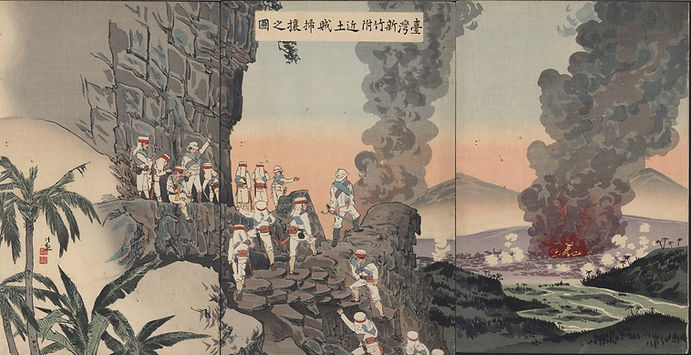甲午與乙未戰爭浮世繪
Ukiyo-e of the First Sino-Japanese War and the Cession Of Taiwan

小林清親/臺灣新竹附近土賊掃攘之圖
Kobayashi Kiyochika / The Suppression of Bandits near Hsinchu, Taiwan around 1895


楊齋延一/臺灣新竹縣征服之圖
Yosai Nobukazu / The Conquest of Hsinchu, Taiwan, 1895

小林清親/精銳我軍占領澎湖嵨之圖
Kobayashi Kiyochika / Elite Japanese Army’s Occupation of Penghu Islands in Taiwan
甲午與乙未戰爭不僅是改變東亞局勢的關鍵事件,在當時也是日本錦繪的重要題材。如小林清親(1847-1915)與楊齋延一(1872-1944)等著名畫師,透過錦繪傳達日軍在臺作戰的進程與視角。
三幅作品呈現日軍與清軍(或在地義勇軍)交戰的不同情境,包括登高遠望城鎮、海陸夾擊的新竹對峙,以及以鏡像式構圖強化虛實交錯效果的夜景場面,在光影變化中暗示戰爭的殘酷。作品各具特色,而作為緊貼時事發展的文化商品,也反映當時日人對戰事的關注與期盼。
The First Sino-Japanese War (1894) and the 1895 cession of Taiwan were key events became major themes in Japanese nishiki-e (brocade picture). Artists like Kobayashi Kiyochika (1847-1915) and Yosai Nobukazu (1872-1944) were known for depicting wartime scenes, conveying the Japanese perspective on battles in Taiwan.
The three prints presented here show various moments of conflict between Japanese troops and Qing or local forces—overlooks of distant towns, land-and-sea assaults near Hsinchu, and dramatic night battles with mirrored compositions. Light and shadow are used to evoke the harsh realities of war. As cultural products closely tied to current events, these prints reflect the Japanese public’s engagement with the unfolding conflict.
